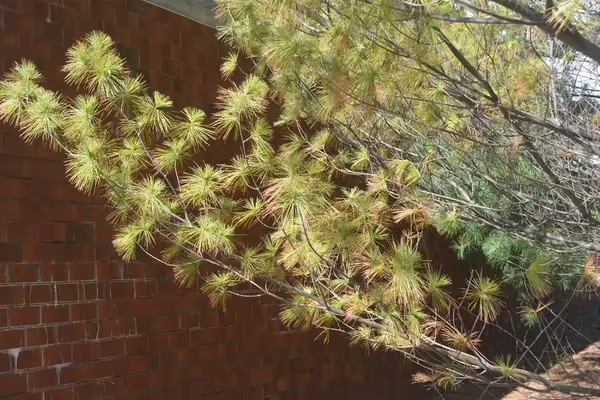
URBANA, Ill. – Like their deciduous maple, oak, and dogwood neighbors, evergreen trees drop some of their foliage in the fall. But needle drop in white pine trees can also be a sign of something more serious.
The University of Illinois Plant Clinic frequently receives many white pine tree samples with symptoms pointing to decline, a condition caused by environmental stress.
“Though considered an adaptable species, white pines seem to grow with intermittent success in Illinois,” says Illinois Extension Specialist in Plant Pathology Travis Cleveland. “White pine decline is a result of stress, especially for trees planted outside the species’ requirements.”
Cleveland wrote an article about white pine decline in a previous 2020 issue of the Home, Yard and Garden Pest Newsletter.
Early symptoms of decline include yellowish-green or browning needles that drop prematurely and thin out the tree’s canopy. The bark on the branches appears shriveled or wrinkled. Underground, the tree’s roots are usually sparser and finer than healthy trees. In some cases, a single tree in a group may be the only one affected.
White pine decline is different than seasonal needle drop that happens in the fall in response to shorter days and cooler temperatures. Illinois Extension Horticulture Educator Ken Johnson says while needle drop may be alarming, it is normal this time of year.
“Only the oldest needles are dropped during fall,” says Johnson, who wrote a blog about fall needle drop. “Just like in deciduous trees, the older needles on the inside of the tree canopy will begin to turn yellow, brown, or reddish-tan when it is their turn to be dropped from the tree.”
Fall needle drop occurs uniformly throughout the tree from top to bottom. If entire branches or needles at the tips of branches begin to die, if the pattern is not uniform through the tree, or if drop happens at other times of the year, something else is happening and warrants a closer inspection.
White pine performs best in moist, sandy loam soils. Many of the samples submitted were from trees growing on sites with heavy clay soils, often with high pH levels.
“An overall trend toward wetter spring climate may also be a contributing factor,” Cleveland says. “Excessive rains saturate soils resulting in a lack of oxygen and impaired root development that later damages the tree more when it cannot tolerate extended dry spells.”
Prevention is the best way to manage decline since it's difficult to reverse once it begins. Plant white pines on sites and in soil conditions suited to the tree.
Afflicted trees do not pose a threat to surrounding trees, and immediate removal is not necessary.
Watering during dry periods and adding a 3- to 4-inch layer of a natural mulch over the root system can help. Applying an acidic fertilizer specifically for pines or acid-loving plants may also help.
More information about white pine decline and other pest issues is available at hyg.ipm.illinois.edu.
SOURCES: Travis Cleveland, Illinois Extension Specialist, Plant Pathology; Ken Johnson, Illinois Extension Horticulture Educator
WRITER: Emily Steele, Media Communications Coordinator, Illinois Extension
ABOUT EXTENSION: Illinois Extension leads public outreach for University of Illinois by translating research into action plans that allow Illinois families, businesses, and community leaders to solve problems, make informed decisions, and adapt to changes and opportunities.
PHOTO ACCESS: Photos and captions related to this article are available for media to download.
